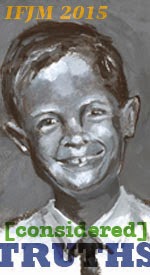As we ramp up to the start of the 2011 International Fake Journal Month I have had a stream of questions about Fake Historical Journals. People have outlined what they intend and it's clear they aren't making a fake journal at all but a "faux" journal. And then there is the matter of the
Fake Historical Journal itself which I've written about at the link provided here.
Here is the scoop as concisely as I can make it.
Fake Journals
A fake journal is a journal that is kept by a character of your creation. It is kept day, by day, as any other journal would be. The entries are dated with the date that it actually is on the date it was written, i.e., today's journal entry would be marked 3/14/2011. What is fake about the journal is the fact that the character is not you, and the character is not writing about your life (exception: alternate universe self—but I don't need to explain that to you do I? Go watch
Jet Li in "The One" if you don't understand alternate universes as they relate to the self.)
You must keep a fake journal in first person singular, unless your character is a complete and pompous git.
For example: You are writing today, March 14, 2011. Your character is named Charlie and he writes in his journal (with attractive illustrations which we won't show here):
Correct: I went to see "The One" starring Jet Li today and I found that it was an interesting look at alternate selves in alternate universes. March 14, 2011.
Incorrect: Charlie went to the cinema to see "The One" starring Jet Li today. He thought it was an interesting look at alternate selves in alternate universes. March 14, 2011.
So to recap: a fake journal is a daily (or almost so) journal, with dated entries that relate to the ACTUAL date on which you are creating the entry as your character; the entries are created by a character who is not YOU (see exception above); the entries are written in the first person singular.
Fake Historial Journals
A Fake Historical Journal is also a fake journal, but it falls into a subgroup of fake journals. Like a fake journal it is written by someone who is not you (i.e., a character you are adopting while you write/draw); and it is written in the first person singular
. Here's the difference: the entries are dated with the same date as the current date on which your are creating the page, HOWEVER the date's YEAR is changed to the historical YEAR you want to reflect.
For example: This time let's say you are doing your entry on April 15, during this year's International Fake Journal Month (2011). Your character is named Lillian; she lives in NYC; she is living in the year is 1912. She writes in her journal:
Correct: This morning I read in the newspapers the horrific news that the Titanic has sunk. No further details are known for sure at this time. April 15, 1912.
Lillian is writing in the first person singular—"I read." The entry is for the day on which you are writing in the present time, i.e., April 15, 2011. But the entry is labeled April 15,
1912 because that's the year in which your fake historical journal is set.
Problems with Historical Fake Journals
Before I leave the definition of historical fake journals I want to point out the difficulty and problems with them.
To write a convincing and satisfying historical fake journal you have to do a lot of research. You need to know the events that did happen, or could have happened, in April of the year that your character is writing about. You need to be well versed in the language of the time (for instance in the 1800s "intercourse" was used to describe more than the sexual act). You need to know about the history of technology so your character isn't turning on an oven without filling it with wood, or using gold coins when paper was the norm, etc. You need to know the manners of the time.
The last is probably the most important. If you have ever read a Henry James novel you will know what I mean. For instance, how does Isabel Archer know that her husband has had an affair with the woman Isabel thinks is her friend (I don't recall the character's name, think Barbara Hershey if all you've ever done is viewed the movie)? She knows because when she enters the room at one point the woman is standing and the man is seated. That's not etiquette, and the little wheels start turning in Isabel's mind. Her thought process works in ways that no contemporary heroine's thought process would work and her observations tell Isabel that these two folks are intimate (in all senses of the word, both modern and historical).
This can be extremely fun, the research, the creation of an historical world where you play with all the social and psychological aspects.
But I tend to discourage people from writing an historical fake journal for IFJM because of the time commitment. To make it satisfying you really have to do, as I said, a lot of research.
Also the focus shifts from your own self-discovery (not your character's now but YOURS) as you work through another person in an historical period that is not your own. You've added an additional layer that is like gauze hanging in your face. This can be a useful examination, but it might be more than you can cope with in one month during IFJM.
Faux Journals
A faux journal is not really a journal at all just as faux diamonds aren't real diamonds.
A faux journal has none of the aspects of journaling. It is not written daily. It is written by the author as a work of fiction often created in a day's worth of binge writing out of which come entries with dates all over the place, instead of the date that they would have been written had it been an actual journal (real or fake). You might actually get the writing correct, i.e., have the first person singular,
but there is nothing else that is journal-like about the faux journal.
One of the important characteristics about fake journals is that they are written like journals are written, on a daily basis.
If you write a faux journal and do 10 entries on a free Saturday, and label those entries April 1 through April 10, 2011, you haven't created a fake journal.
You haven't been journaling. You've simply been creating a fiction written in the journal format.
I have nothing against faux journals (there are some interesting works of fiction created as faux journals), but they don't have a place in International Fake Journal Month because they aren't fake journals. They aren't journals at all.
To derive any benefits from IFJM you actually need to work in a journal, actually journaling, day by day. That's the point. It's from that process that you learn something about yourself, about journaling, and about how your creative mind works.
If you create a faux journal, for instance by working feverishly on those 10 entries on a single Saturday afternoon, you might learn something about your creative process, but it is your creative process for writing fiction, not journaling. And you haven't learned anything about journaling that will be of use to you in your real journal.
More on Faux Journals: Either Contemporary or Historical
Faux Journals are simply works of fiction written in the journal format as mentioned in the Faux Journal section above. They are not journals since they weren't written within the constraints of a journaling practice. They then become simply faux journals. These do not have a place in IFJM. They do no meet the criteria of a fake journal as outlined above under Fake Journals.
The past two months I've had several people write to me excited to write an historical fake journal. However, when they describe what they want to do they explain that one entry will be in June 1861, one entry will be in October 1861, the next in November 1861, and so on.
What those people are intending to execute is an historical work of fiction written in the journal format. This is a faux historical journal.
I've encouraged anyone who wrote to me about that to continue with his or her plan outside of IFJM. They are obviously interested in a character they have in mind. They are eager to write a fiction around that character.
But they don't want to be contained by the structure of a fake journal (historical or otherwise).
I have encouraged people interested in writing a faux historical journal to join with the writers at
NaNoWriMo (National Novel Writing Month) which is held every November from November 1 through 30th. That is an appropriate venue for writing a work of fiction in a "group" setting, within a month—whether historical or not, or in journal format or not.
Why Definitions and Distinctions Matter
Now that I've explained the difference between Fake Historical Journals, Fake Journals, and Faux Journals of all kinds, I hope that you'll consider joining me in April to create your Fake Journal (or Fake Historical Journal if you're comfortable with the extra work and research).
I bother with these definitions and distinctions because I want you to have the best possible experience during IFJM.
I want you to come away from the project with the greatest insight possible. I hope that each of you discovers something new about how to work in a journal, how to see with a fresh eye, and ultimately how to let go of the clutter that is hampering your actual journaling habit.
I bother with these definitions and distinctions because I don't want you to jump gleefully into the creation of a fake historical journal and them come up for air screaming, "Why didn't Roz warn me there would be so much detail work, so much research!?"
My goal is not to make your life miserable for a month. My goal is to prepare you to have the best fake journal experience you can have, by pointing out the ins and outs. I've been creating fake journals for decades. I know that some approaches are easier than others (i.e., anything is easier than a fake historical journal). I know that some concepts are overwhelming to accomplish unless you take the month of April off—and which of us can do that?
International Fake Journal Month is about taking a small task you can do everyday, build on everyday, and learn from everyday. It's also about having fun. So if you understand the definitions and distinctions you're going to have a chance for success (however you define it) and a chance for greater fun.
I hope this post helps to that end.
Let's not lose sight of the motto of IFJM:
Life's so short, why live only one.
Life, any life real or fake, is lived one day at a time, and journaled about one day at a time.













